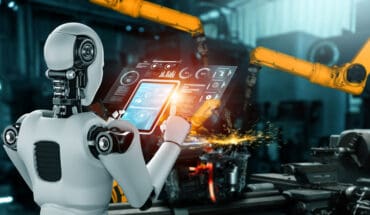
A five-year timeframe for shifting to intelligent systems may be tighter than it first seems.
The clock is ticking on organizations looking for a successful transition to enterprise-wide intelligent systems. They have five years to make it work, starting now.
Five years may seem like a long time, but success requires enterprises to clear some common hurdles. Those include the presence of legacy systems, data silos, lack of compute power at the edge, and integration of diverse systems in an environment that leverages machine learning and real-time collaboration.
Those intelligent systems provide the infrastructure that underlies broader data-centric initiatives such as the emerging concepts of continuous intelligence and observability.
![Featured Resource: Continuous Intelligence and the Era of Real-Time, Data-Driven Business [Download Now]](https://no-cache.hubspot.com/cta/default/8019034/9769f547-fc63-40f1-b242-fd20e3451bf3.png)
Digital transformation company Wind River highlighted the challenges and opportunities for companies in major industries via a report issued recently. In a survey of more than 500 tech leaders around the globe, Wind River found that 62% of tech leaders say their companies have “embarked on a journey to become intelligent systems companies”.
Plus, 8 out of 10 respondents want to prove success within five years, with 16% of those leaders saying they expect to achieve a haughty four times the ROI of their peers.
The respondents represented core industries. Respondents were in manufacturing, energy and utilities, aerospace and defense, medical technology, automotive, and telecommunications.
Intelligent systems characteristics
So, what will an intelligent systems company look like?
Wind River suggested 13 elements that companies may have now or can expect to utilize within their five-year window.
The characteristics that respondents rated as most important were led by “true compute on the far edge”, which Wind River cited as “foundational over the next 3-to-5 years”. Take the example of an Internet of Things environment. That could mean that embedded devices operate autonomously and perhaps that more intelligence shifts from central systems to those edge devices.
Other key characteristics included automated learning and machine learning functionality; near-real-time seamless ecosystems connections; real-time collaborative workflow platforms; and digital feedback loops that influence product development.
Respondents said those latter two elements need to have their infrastructure in place today.
The key elements needed within individual industries and the status of those elements did vary. Here are some examples.
See Also: Continuous Intelligence Insights
Manufacturing
With 2.7 million robots already at work and more on the horizon in manufacturing, the edge matters today. “Delivering compute on the far edge, predicting stresses, resolving failures, and customizing devices in the cloud — these are all foundational capabilities for success that must be delivered in a single, real-time, collaborative workflow,” said the report.
Yet, the research showed just 11% of manufacturing companies “already see themselves as intelligent systems digital business companies”. Another 55% of the rest strive to get there.
Energy and utilities
Wind River said the five-year vision for energy is focused on automated learning and machine learning. “Manufacturing leaders are looking to a combination of cloud-based device customization, predictive systems management, and the sequencing of necessary workflow processes to create a clear path to practical success,” said the report.
Energy sector respondents said that “foundational capability of compute on the far edge is over 10 times more important than being able to run experiments as a learning system”.
The report said that 41% of energy and utility respondents believe intelligent systems can positively transform how carefully and efficiently we use environmental resources.
Aerospace and defense
Artificial intelligence is crucial in this sector. Wind River quoted research firm CB Insights commenting on the report data: “In the aerospace and defense industry, supporting software has to make quick decisions in high-risk scenarios. Artificial intelligence is becoming integral to the $8.7T space as companies and government agencies explore using technologies from robotics and autonomous systems to cybersecurity and telecommunication for national security.”
Respondents highlighted the need for true compute at the far edge and the ability to emulate and simulate in real time as the most important characteristics of intelligence in aerospace and defense.
The research also highlighted the need for the ability to “synthesize workflows with one process for all parties involved and the use of tools such as digital feedback loops in new product and service development”.
Medical technology
“Alan Turing’s idea of the imitation game was a precursor to current thinking about intelligent systems inside the medical industry. The application of intelligent systems for preventive maintenance and innovation is extremely exciting,” noted the Wind River report. It then said that the medtech field requires more investment today than any other vertical.
The report cited Accenture data showing that in five years “AI alone could save US healthcare $150 billion annually”.
The keys for medtech include a real-time collaborative workflow platform combined with the ability to cycle data in feedback loops back into product development, detect events, resolve them, and deliver total automation.
The downside, according to the report: “While 78% of leaders in medical technology companies are on a pathway to building intelligent systems, one-third of them are not succeeding”. So, there’s still plenty of work and innovation needed in medtech.

Automotive
The automotive industry is a bit further down the road when it comes to intelligence systems. Of course, automotive has been going through a series of revolutions over the past few decades. That trend will continue.
The report notes, “The infrastructure characteristics that automakers implement in the first three years will account for 70% of the total impact of intelligent systems on the industry.”
It goes on to say, “Getting the sequence right and focusing on building the right sets of intelligent systems characteristics are both key to success.”
Citing the “increasingly diverse world of revenue opportunities” in automotive the report said that a collaborative workflow platform is needed, even if it doesn’t have a major impact in the near term.
That “diverse world” in the automotive sector is one where the business is not longer just about building cars but also developments such as how cars are now valuable sources of information about consumers and the evolution of the vehicle ownership business model.
The report said automotive should build out three key elements of intelligent systems in the next three to five years: The ability to have true compute on the far edge, the ability to predict stresses and failures and resolve them, and the ability to customize device experience in the cloud.
One of the factors making automotive special among the major industries was noted by the report. It said, “The automotive industry has unique drivers for success. The most important characteristic of intelligent systems for success of organizations is that they can be built, developed, and operated using simulations or emulations to increase productivity and reduce time-to-market.”
Telecommunications
While TV commercials for telecom companies focus on the move to 5G, the key for the sector, according to the report is to become “complete intelligent systems companies”. That starts with “a real-time collaborative workflow process along with the ability to customize devices on the edge”.
In the survey, a third of carrier leaders in the US said they believe their organizations are committed to the idea of intelligent systems as core to their futures. “Yet the chances of success, even within that group, run at only 54%. Being committed to the idea is not a guarantee,” said the report.
Survey respondents said that within three years, the telecom sector will have a clear focus on creating an intelligent systems future, have core business practices in place that contribute to an intelligent systems future, and have their embedded products/services completely developed for intelligent systems. “This is an aggressive short-term view compared to that of the other sectors,” said the report.
“Only the automotive sector has equal focus on the key intelligent characteristics needed now: true compute at the edge, the ability to simulate and emulate in near real time, and digital feedback loops that connect data to products and services,” said Wind River.
It added that 90% of telecom leaders believe that over 50% of their embedded products and services will need to work on the far-edge cloud, within less than three years. Sixty-three percent believe their products and services will be infused with AI and ML in the next three years.
“In five years, two key characteristics can become realities: total automation and the ability to act based on sensory data and algorithms,” concluded the report.






